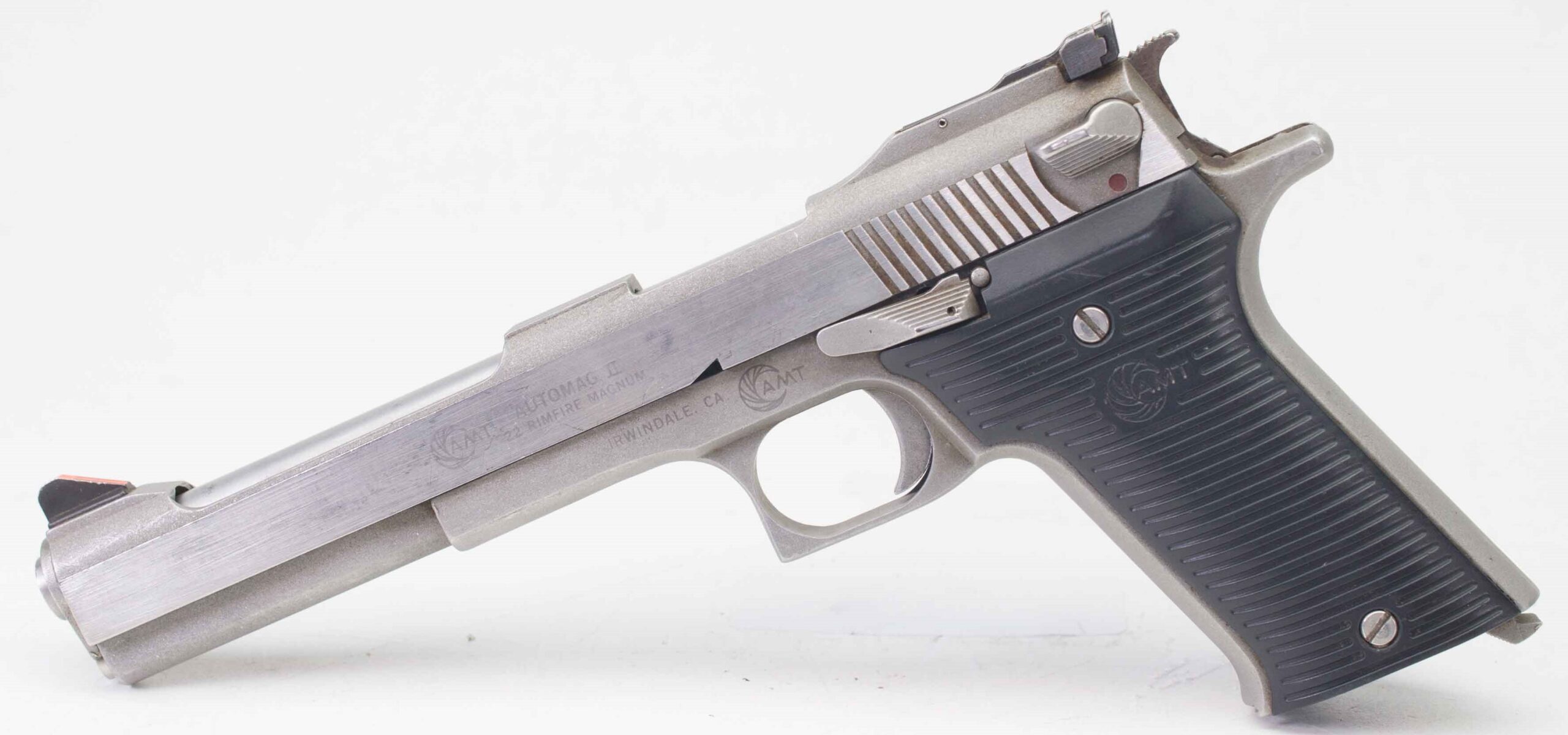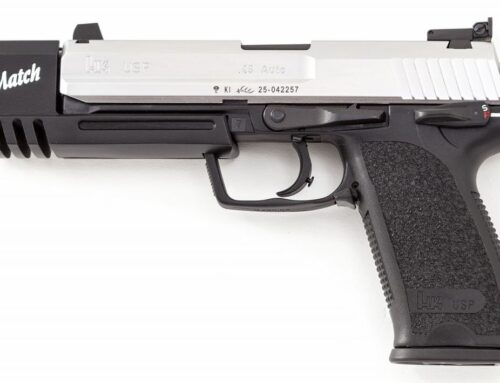With current trends in the firearms industry it seems everyone is copying everyone else’s homework. New guns appear to be conceptualized by committee, requiring so many “feature checkboxes” to be ticked in order to meet some demands out of marketing. Rare is it to find proper free spirited thinking and when one does it usually comes at a staggering premium. These days if you want something different or, dare I say fun, sometimes looking forward isn’t the answer. Sometimes it’s best to look back.
For those who may remember one of the original semi-auto hand cannons of late, the AMT Automag chambered in the proprietary .44 Automag, AMT (Arcadia Machine and Tool) didn’t just stop with one with the first sequel coming out around ’87. It was still silly large, made of stainless steel, and largely unlike anything else available at the time (or to this day,) but it was lighter, friendlier, and didn’t require its own cartridge. The Automag II was a .22 Magnum in a semi-auto format, the very first of its kind.
These .22 magnum pistols have been starting to come back into favor lately, a trend which was no doubt started by Keltec with the PMR-30. More recently we’ve had the Walther WMP and Smith & Wesson M&P 22 Magnum, as well as the Rock Island Armory M1911 A1 XT and one called the Accelerator by Excel. While these modern takes generally have better reliability, higher capacity, and most are backed by larger names, there’s a few things which the old school Automag II does better.
To start, the Automag II could be had with a hilariously awesome six inch barrel.
Built more like a 1911 with a front barrel bushing and single action with external hammer, but also having an open top slide more like a Beretta, the Automag II’s proportions are both highly distinct and a bit awkward. In fact, the first BB pistol I had ever purchased was the Crosman Auto Air II back in the early 90’s or so. Back then I wasn’t so familiar with the Automags, they had been elusive enough to escape my attention for some time, but a plastic representation was striking enough that I had to have it.
In proper 80’s and 90’s fashion AMT also had the Automag III, IV, and V, all of which are silly massive but whimsical as hell.
The Automag II in particular could be had in three variants. The nine round 6″ and 4.5″ barreled versions both have sections cut from the slides to reduce mass, and a compact seven round version with a barrel shy of 3.4 inches. You can almost fit a tenth round in the full size mags but the rim starts to get caught up under the feed lips. I wouldn’t recommend forcing it.
To address an elephant in the room: Yes, AMTs don’t have the best track record. Their quality is questionable, their reliability can be up in the air, parts are known to be fragile, and these days finding replacements are virtually impossible. I have recently handled an AMT branded 1911 (naturally all in stainless down to the magazines) and while it felt fine there was still that hint of grittiness which is kind of a hallmark of the brand. The polished surfaces are not all evenly and uniformly polished. There are also visible machining marks to be found, most notably within the trigger guard on mine.
As for durability, the Automag II is no exception. The hammer strut is known to severely bend should these pistols be dry-fired (which you generally shouldn’t be doing with a rimfire in the first place) and after as few as three of these “oopses” the part can either break or be too far bent to save. The extractors are known to batter themselves into oblivion so be sure not to let the slide slam home on an empty chamber. The original style firing pins had a problem with breaking, necessitating a later redesign.
There’s also the matter of the guide rod. The Automag II can be a wonderfully accurate pistol. It can also have shotgun-like accuracy with groups opening up to nearly one foot at seven yards. Amusingly, this is all down to how the guide rod is aligned when reassembling. Unlike …almost every semi-auto pistol out there, the Automag II’s guide rod doesn’t have any bump, detent, cut-out, or guide to make sure it nests exactly where it’s supposed to. Instead you have a broad flat surface meeting a broad flat surface which is the barrel lug and you sort of have to hope it works out for the best.
When incorrectly installed the tip of the guide rod will protrude slightly out the front when the slide is in battery. Retracting the slide will cause the guide rod to tilt down at a steep angle away from the barrel. This will absolutely destroy your accuracy, quite possibly your reliability, and I strongly suspect is why the base of my guide rod is all chewed to hell. Installed correctly the guide rod is parallel to the barrel and is flush up front with the barrel bushing, all nice and tidy.
For controls and handling the Automag II is a single action only external hammer fired design with a slide mounted thumb safety on the left and a slide catch which can be slightly out of reach of your thumb. The grips are naturally long and skinny and the ribbed black polymer grip panels really do nothing to provide any traction. They sure look nifty, though. That ribbed pattern grip is one of AMT’s signatures, in fact.
The iron sights are quite nice with a bright fluorescent orange front blade and an adjustable rear. Both of these sights have some fun extra lines to them. Up front the squared dot has a narrower “runway” running down toward the slide, which does make it easier to pick up. To get a correct sight picture simply cover up the “runway” with the rear sight until all you have is the box nested within the rear notch. The back is similarly over-marked, starting with a squared off white U much like a Glock but with thin wings extending outward along the top edges and another “runway” going straight down the center.
It’s an 80’s thing. …I think.
Considering .22 magnum wasn’t terribly commonplace when the Automag II came out it was designed specifically for just one type of ammo: 40 grain Winchester Super-X. Because the caliber is intended for rifle use AMT did a nifty trick involving a barrel sleeve and 18 small holes drilled into the chamber. I have read conflicting stories about why this was done, however.
One story is that the brass would briefly expand into these holes to help hold the empty case in the chamber while the bullet rips down the barrel, a means of mechanically delaying the unlocking of the action. A different story is that it’s more like a roller-delayed HK where gas is vented into these dimples in order to help release the brass from the chamber to aid extraction. Exactly which is correct I honestly don’t know, but somewhere after AMT was bought out by High Standard around 1999 (and a few others in between) it seemed they no longer drilled these holes. For a time Numrich had sold factory replacement components and some internet-goers had reported those barrels had no such chamber holes. I’ve also read online that these extra holes are a pain to clean and the gun will have some cycling issues if they get clogged up, so… You know. There’s something else for new Automag II owners to look forward to. Yay, me. At least it makes for interesting patterns on the spent brass.
Side note for those curious, if you see a black magazine follower then it’s an original AMT. If you see an orange follower it’s one of the newer ones (likely all made by High Standard.) The new ones have a different design for the baseplate and visible weld blobs along the spine of the body which leads to a tighter fit but both seem to work in my earlier Irwindale marked gun and lock the slide back.
Shooting the Automag II is plain cool. You will absolutely notice which ammo types are loaded hotter than others with some producing monstrous fireballs and range-thundering booms while others handle more like .22 Long Rifle with almost polite reports and no flash at all. Either way, reliability was shockingly good with my example. Armed with ten (might have been eleven) brands and types of .22 magnum ammo I found accuracy to be virtually identical across the board with only one having caused any issues. CCi “Maxi Mag” hollow points, grain unspecified and quite possibly about as old as I am, caused notable blowback with weak ejection and one minor related malfunction. I do not know if this ammo is made anymore.
Notable highlights are the “proper” loading of Winchester Super-X but mine also took to Hornady’s 30 grain V-Max quite nicely. Additional offerings include Remington, Speer Gold Dot, Federal Game-Shok, Fiocchi, CCi V-Max and TNT Green which all happily chugged along without complaint, albeit most were a five round test to go “yup, those work.”
Being all stainless, the Automag II does heat up quickly. I would treat it as a target or small varmint gun, you wouldn’t want to mag dump or blaze away with one. After fifty rounds mine was starting to edge into uncomfortable territory. It might be interesting to see if a hot chamber causes feeding or ejection issues
No lie, I love these guns. They aren’t the best, they’re super finicky divas, but my word they are fun. In fact, compared to the Keltec, Walther and Smith, I would take an AMT over the others hands-down.
See, the thing about the others is that they’re just. Not. Cool. Walther and S&W went and made .22 magnum pistols which look very much like every other modern black polymer framed handgun. If you ask me, this is exactly the opposite of the point! A .22 magnum pistol is the sheer definition of impractical. Pressures and burn rates vary wildly across ammo options and the caliber as a whole is designed for a rifle barrel. Trying to get a .22 mag to reliably cycle in a semi-auto, especially as a pistol, is a special kind of lunacy. They are also obnoxiously loud fire-breathers at the range. You don’t make a gun like this for the masses, you make them for a niche audience. Enthusiasts who want to try something different and have a good time. People who want a little more out of the rimfire experience.
So why then did these other gun makers not do something wild and crazy and FUN with what should be a wild and crazy and fun handgun? AMT certainly did. The Keltec PMR has a good chance to stand out in a crowd but the Walther and Smith are invisible amongst the masses. But an Automag II? Oh, you will notice them. Nearly 40 years later, you will absolutely notice them.
Mine may well fall to pieces before I do, but so be it. These guns were made to be enjoyed and I’m looking forward to making more fireballs.








